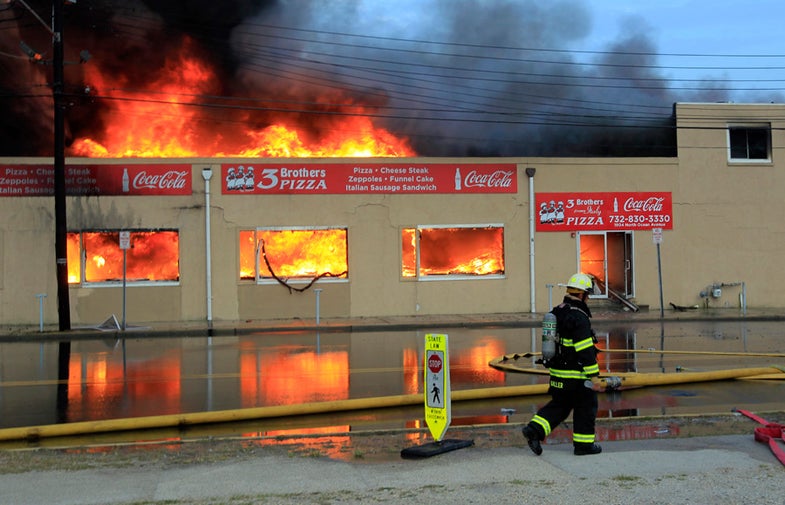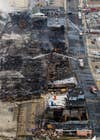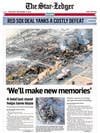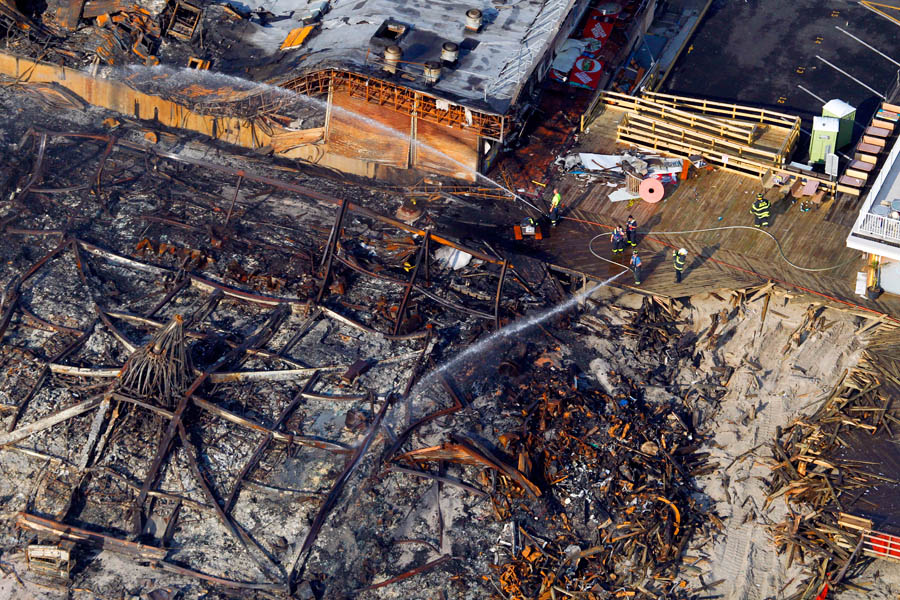Behind the Lens: Andrew Mills on Photographing the Seaside Boardwalk Inferno
_Andrew Mills is a veteran photographer at The Star ledger, New Jersey’s largest newspaper. He came on staff in 1996...


Aerials of Seaside Boardwalk fire aftermath

Fire destroys Seaside Boardwalk

Aerials of Seaside Boardwalk fire aftermath

_Andrew Mills is a veteran photographer at The Star ledger, New Jersey’s largest newspaper. He came on staff in 1996 and since then, has done two tours overseas for the daily, one in Israel and one in the Gaza Strip. He has photographed countless breaking news and professional sports events. Andrew describes himself as a ” peak-action, spot-news kind of guy,” and we couldn’t agree more.
A former resident of New Jersey myself, I’ve paid close attention to Andrew’s work, covering the response to Hurricane Sandy, as well as the clean-up and rebuilding of the New Jersey Shore communities, over the course of the past year. So when a massive fire broke out on the famed Seaside Heights Boardwalk late last week, a boardwalk I visited often as a child, it was once again Andrew’s photographs that affected me most. The Associated Press, Getty Images, Reuters, none of these news organizations offered as comprehensive visual coverage of the disaster as Andrew and The Ledger did.
We spent some time chatting with Andrew once things calmed down a bit. Not only about covering disasters, but about the health of the photojournalism world in general.
Dan: Andrew, thanks again for taking some time to chat. First off, can you give me some background info about yourself, and your time at the Star Ledger?_
I’ve been at The Ledger since 1996, before that I did a couple years at the Asbury Park Press in Neptune. I was hired in ’96 to manage “The Shore Bureau.” That lasted about a summer, than I got moved up to general assignment. Primarily, I do professional sports and high-profile news assignments. I traveled overseas when the Gulf War started and did two tours over there. This was when we had more of a national presence. Post-Sandy I’ve been doing a lot of Jersey shore stuff, and covering the Giants and Jets.
Do you like the current split between news and sports?
I’m a peak-action, spot-news kind of guy. I’m not one of these great feature-type photographers. The pictures they make are just unbelievable, I don’t do that kind of stuff. It’s a credit to the talent of some of our staffers.
Tell me a little bit about the Seaside boardwalk fire, when did you get there?
I live in Manasquan. I’ve literally been to the Newark office three times since June. It’s been such a hard year here, they kind of cut me loose a bit to work on my own project. We were so overwhelmed with Sandy, from Halloween to Saint Patrick’s Day, I literally did not have a day off for 6 months. Of course Thursday, we had this huge meeting scheduled to go over this project I’m working on, up in Newark, with all the bigwigs, managers, managing editors ect. I had to sit down and show them what I’ve been up to the past 2 months.
As I’m walking into the meeting I look up at the TV monitor over the photodesk, and I see a picture of the Kohrs ice cream stand burning. And one of our photo editors is freaking out ‘We need to get photo!’ And I’m like, ‘Nah, it looks like it’s out.’
So I go into the meeting and come out an hour later. I’m walking through the newsroom and I look up at the TV and I see all this black smoke, and flames reaching the sides of the boardwalk. And I’m like ‘Holy cow! That is still burning? They’re going lose the whole boardwalk, we need to get moving!’
At that point, everyone just kind of stopped what they’re doing and looked at the screen. And here I am, the spot news guy, standing in Newark, and there’s a fire burning 8 miles from my house, and I’m 50 miles away.

Aerials of Seaside Boardwalk fire aftermath
We didn’t have a still photographer there, only a videographer, so my editor said ‘Just go.’ So I just jumped in the car and started going. I fly a lot, I’m one of our main aerial guys and I have a couple pilots that I fly with. So I’m driving up the Turnpike and calling my one pilot, trying to get him to pick me up in Linden, which is where we fly out of a lot. And he’s like ‘We can’t take off, there’s a huge storm front coming in, let’s try for Old Bridge instead.’ But he couldn’t get there either, so we decide to try Monmouth Executive Airport in Belmar, which is where I normally fly out of.
I’m now thinking the fire is going to be out before I get there. And I want to be there when there’s flame. So I get to Belmar. He’s gearing up, doing the pre-flight. And I look up at the sky and there is just a massive thunderstorm coming in. And he’s like, ‘Dude there is no way we’re going to be able to lift off before this storm comes through.’
So I call a chopper guy in Lakewood. But he had just gone up and wouldn’t be back for a half an hour. So I tell him that I’ll meet him at the airport when he lands, and to keep the engine running. Which was perfect because Lakewood is only about six miles from the fire zone. I figure we can fly a lot lower in the chopper anyway; get in and get out before the heavy storm starts.
So I get to Lakewood and sure enough, we’re grounded there too. At that point, I had no choice but to go in on foot. The Route 37 bridge is shut down for emergency vehicles. So I go in the backway, I kind of talk my way through some of the majorly hit hurricane neighborhoods. I was able to get through there, just from the hurricane experience, I know who’s who and what roadblocks are where. Got to the fire scene finally, and it was still ripping, it was raging.
The fire’s been burning now for 3 hours, out of control burning. When I got to Ocean Terrace, it was literally ablaze. Kind of walked right into a wall of fire, while most of the other photographers were covering the press conference by the governor.
They booted me pretty quickly after, though. The thing is, you want to get those flames, the action, while everything is still moving.
When you get to a fire like this, what kind of mind-set do you go into?
It’s almost like when a paramedic arrives on the scene, it’s triage. You try to figure out what’s going on and what’s the most effective route in telling the story. I’m trying to find things that show the viewer exactly what’s going on, I’m trying to stop time. You have to realize that your job is preserve history.
Growing up in the metro New York area, with 9/11, so many of these images are really important. And you realize you have to get whatever you can get. And with these fires, its really important to get in and shoot before everyone is blocked out, before the police can secure the area. Get in while the fire is still active. The best pictures are the ones taken before the perimeter is set up. Get in, get what you need and get the heck out of there.
You don’t want to ever have a confrontation with an officer because they have better things to do. And you should be creating images, if you’re arguing, you’re missing pictures.
It’s a lot easier said than done [laughs]. As we saw in Seaside. There weren’t many pictures, there weren’t a lot of photographers who made it out.
Being in the right place at the right time is part of the game. That’s how I got my big break actually. I was in the right place at the right time in the early 90’s. I got a spot news picture that landed on the front page. And afterwards, the chief photographer said, ‘Hey, what are you doing? Come on in. Start stringing for us, we can give you some work.” and that’s how my career got started.
So when did you finally get up in a helicopter to shoot it from above?
We were the first ones up the next morning. We were literally waiting at 6000 feet for the clouds to break, before going down to check it out. It’s a little crazy, you don’t have a lot of instruments in these helicopters. We were talking to the control tower , they were being our eyes, they have radar.
I didn’t know what to expect to see. I knew the damage was bad, but I wasn’t expecting anything like what I saw when we came out of the clouds at around 800 feet. I’m like ‘whoa it’s gone.’ It was just, you know, the armageddon that it was.
I feel like it was the aerial photos that give a full understanding of the scope of the destruction. Seeing photos from the ground, it’s hard to understand what exactly was burning.
You know, the whole not being able to get up there the night before was actually good, because I saw what one of my friends from Asbury, who did get up to shoot, I saw his photos. It was just a whole lot of black smoke and not a lot of detail.
When you actually see the carousel gone, you can just see the frame of it, its unreal.
How much does the emotional connection come into play for you? Covering Sandy must have been particularly tough having it hit so close to home.
Our town got hit unbelievably hard by the storm. We also had a major 12 house fire right after the storm. We had an inferno. They let us come in right after Thanksgiving, to start working on our houses, repairing. And the next day, 12 houses burned down.
I was literally there that day before the fire department got there. It may not have been as destructive as the Seaside fire, but for our town, it was equally as traumatic.
The boardwalk burning is more symbolic than anything else. But the fact that no one died is good. You can replace businesses. Over the past three days I’ve even heard people say, ‘You know, maybe this is a blessing, these people can collect insurance and get out, if they want.’

Fire destroys Seaside Boardwalk
But to answer your question, I did not feel any emotional attachment, maybe its because I’m just completely shot emotionally. It’s sad to say, but we’ve been through a whole lot in the past year.
You mentioned that because you had a good sense of the backroads, and the police departments, you were able to get to the scene of the fire. What is your relationship with police in general, obviously as a photojournalist, you’re often at their mercy.
Its a respect thing. I’m the first guy who wants to challenge authority and push the limit. And fight for the right of the first amendment. But when you’re at a scene, you have to do everything in your power to get the picture, but you have to be safe. You’re not doing anyone any good if you get hurt, or god-forbid hurt someone else, or even get in the way. The important thing for me is to do what I have to do, but in a respectful, responsible manner.
They were cutting trenches in the boardwalk, and driving heavy machinery through. They couldn’t wait two minutes to clear people. They had to go. The last thing you want to do, especially in the age when everyone had a phone and everyone is a “photographer,” is get in the way. I work for the largest news organization in New Jersey, and I want to act with respect and portray a sense of professionalism at all times.
With everyone shooting pictures, that professionalism is paramount. We have to maintain our responsibleness. We have a responsibility to cover the news, but also to do it in a manner consistent with what our organization believes in.
Tell me a little bit about the competitive nature of the photojournalism industry?
When there’s a story like this, a fire like this, my attitude is, you’re not going to beat me. I’m not going to let The Times beat me, I’m not going to let the AP beat me. The Star Ledger staff is known for rising to the occasion. There’s a competition there. I’m there to get the picture.
Do you think it’s gotten more competitive?
I think the opposite, I think it’s gotten less competitive. The big newspapers and the syndicates, their photographer numbers are down. I can’t tell you the last time I saw a Times photographer at an event. We use to compete the Gannett papers like tooth and nail. And that competition just isn’t there anymore.
Everything is pooled, everything is resourced. It’s just diluted. There’s so much. A lot of these outlets and agencies and wire services would rather take a picture from an iPhone and put that on the wire rather than wait a few minutes or hour, and for a properly exposed, in-focus image with the right caption info — a photo that you know was created under no false pretenses, with the right standards that we learn in journalism school.
How would you compare covering a breaking news story, to covering a situation like war, something potentially more volatile and unknown?
The number one thing always is be aware of your surroundings. You have to understand that you are in a position where you and everyone around you could suffer great bodily harm. And that being said, you need to also do your job, operate in a manner which will accomplish the task at hand, which is to document the story. Deliver the news that people need to see.
A lot of times you click into ‘Go Mode’, and you’re not thinking the same as normal. You’re looking, you’re looking, you’re looking. It’s like when your driving down the Turnpike and pull up to an accident. You’re looking a lot of times to first help the victim. Again, its like triage. You’re mentally going through a different series of checks in your mind. All the while trying to remain safe, and render aide when possible, you don’t want to become part of the story.
I’ve been on a story where you look over and someone needs help. I’m not going to let someone die in front of me. I’m going to shoot a picture after, but I’ve proven that over the past couple of years. I don’t have it in me to let someone die.
So you’re a human being first and a photojournalist after?
Exactly! If there was anything the hurricane showed us, it’s that I found myself chest-deep in water, with people screaming out of windows for help. What do you do? You have to help them. To be in a position where you have to make that choice, it’s enough. You have to be a human being. You have to do the right thing. I teach my kids to do the right thing, and I would hope all the people in our profession would do the right thing as well.
Anything else you’d like to add?
Anyone coming into the business, should know, you can’t un-see something. You have to be responsible. For example, you go to a car accident, and there’s a fatality. First off, there is no way that photo is getting printed, so why subject yourself, or attempt to subject your viewers, to that kind of image.
You have a responsibility to your readers. Don’t get me wrong, I’m the first guy to stand up and push the limits, and I’ve been thrown out of many things, I’ve been in the back of police cars. The Star Ledger, is a lot bigger than I am, though. I like to think I play a big role in helping make it great, but I’m not bigger than that. The way I act is reflective of the people of New Jersey and of The Ledger.
Keep up to date with Andrew’s work by following him on Twitter, @Andy_Mills_SL and Instagram, @andrew_mills.
